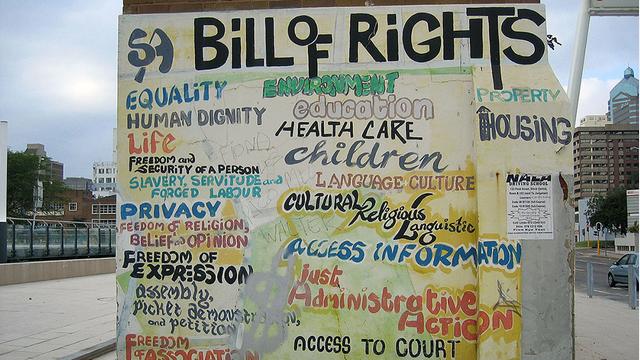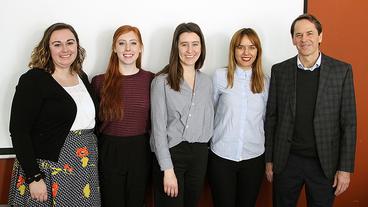Even the most well-known organizations in the world can use help improving the ways they provide services, and a group of students from the Humphrey School of Public Affairs recently had a chance to research how the United Nations can better address human rights violations in countries across the globe.
The five students—Shelby Ankrom, Gonxhe Kandri, Olanrewaju (Paul) Olubayo, Hannah Shireman, and Alli Strong—are all Master of Human Rights candidates, and worked on the two-month long project with Todd Howland, a Minnesota native who works at the UN’s Office of the High Commissioner for Human Rights (OHCHR). In that role, Howland seeks to ensure countries are abiding by international human rights standards, and facilitates change to address noncompliance.
The research team developed an innovative tool, "The Minnesota Method For Human Rights Change in the Field," and presented it to interested students and faculty in early March. The Minnesota Method is designed to be used by OHCHR human rights advisors when they’re sent to countries where human rights violations—from discrimination and barriers to education to voter suppression and arbitrary detentions—are occurring.
Instead of trying to proactively address all the violations at once, an advisor can use the Minnesota Method to determine a few strategic issues where they can have the most meaningful impact.
Gonxhe Kandri, Todd Howland.
“The advisors are deployed to countries where there are multiple human rights violations. Our tool helps them prioritize their efforts,” says Ankrom. “They can focus on a few issues that can be easiest to change, or those of most importance to local leaders.”
Howland says human rights advisors are often on their own when they are assigned to a country, and would benefit from having a formal assessment of the situation at hand when they arrive.
“There are some good practices that exist, but the reality is that OHCHR has not done a good job of identifying best practices and orienting new human rights advisors,” he says. “There is no method right now, so this assessment tool provides a formal method.”
Unique Opportunity for Students
Howland says he was impressed with the Humphrey School students’ enthusiasm when they applied for the project late last year. “They're really committed to bringing about positive change in the world,” Howland says.
He says it’s quite unusual for a group of college students to work on something that may become a UN product, and the students recognize the value of the opportunity.
“Being able to create this tool that is going to be used in practice is very valuable as a student— to say that we did this, and to be able to share it with others,” Ankrom says.
“The collaborative nature of the project, showing that we can work really well with other people and develop this concrete product, is really exciting,” Shireman adds. “It adds another skill to our toolboxes, and shows that we understand theories of change, which is so important in advocacy work.”
Howland says he appreciates the fresh perspectives the Humphrey School team brought to the process.
“The students would say, ‘Why are you doing that?’ or ‘Why aren't you doing this? We learned this in our class, so why aren't you applying it?’” he says. “The product that we ended up creating, the Minnesota Method, was really informed by the academic work the students have done. The process also helped them do something different, in terms of applying something they're learning to a practical outcome.”
Howland hopes this research will stimulate academic interest in the operational work of advisors and the OHCHR; he would like to see more universities conduct more research on this topic.
As for implementing the Minnesota Method, Howland says the final report will be shared with all the human rights advisors in hopes they’ll integrate it into their work and adjust it as needed. He expects it will be formally approved by the OHCHR’s management team and fully implemented over the next few years.



